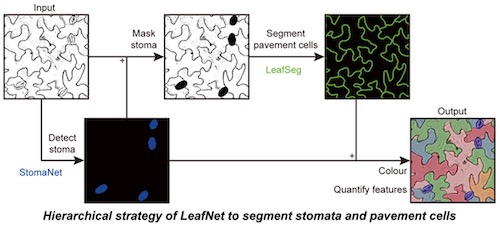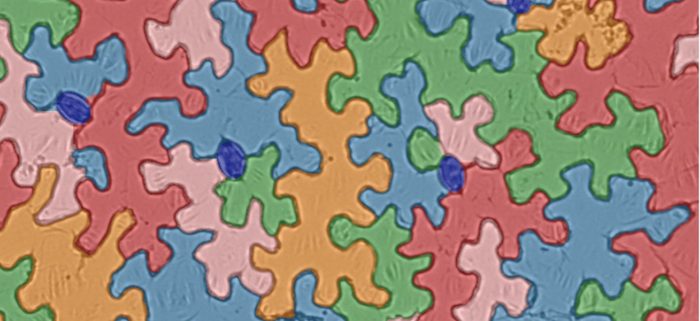LeafNet for automatic phenotyping of the leaf epidermis
Li et al. developed a new tool called LeafNet for segmenting and quantifying stomata and pavement cells.
Background: Stomata are microscopic openings in the leaf epidermis that allow for oxygen and carbon dioxide exchange between a plant and the atmosphere. The phenotypes of stomata and the surrounding pavement cells, including their numbers, sizes, and other morphological features, are important for understanding their functions and regulation. Traditional phenotyping generally depends on laborious and time-consuming manual work by specialists in plant biology. In recent years, several programs were independently developed to detect stomata or to segment pavement cells. However, the accuracy of these method for analyzing light microscopy images from a broad range of species is limited.
Question: We aimed to develop an automatic tool to accurately identify and quantify different features of stomata and pavement cells at the same time using light microscopy images to facilitate plant biology studies.
 Findings: We introduce LeafNet, a tool that can automatically localize stomata, segment pavement cells, and report multiple morphological parameters for a variety of leaf epidermal images, especially images generated by bright-field microscopy. We employed a hierarchical strategy to identify stomata using a deep convolutional network and then segment pavement cells on stomata-masked image using a region merging method. LeafNet achieved promising performance on test images when quantifying different phenotypes of individual stomata and pavement cells in a comparison with six currently available tools. LeafNet shows great flexibility, and we further expanded its ability to analyze bright-field images from various species as well as confocal images using transfer learning. Users can install LeafNet locally via the conda package or directly use it in the webserver at https://leafnet.whu.edu.cn/.
Findings: We introduce LeafNet, a tool that can automatically localize stomata, segment pavement cells, and report multiple morphological parameters for a variety of leaf epidermal images, especially images generated by bright-field microscopy. We employed a hierarchical strategy to identify stomata using a deep convolutional network and then segment pavement cells on stomata-masked image using a region merging method. LeafNet achieved promising performance on test images when quantifying different phenotypes of individual stomata and pavement cells in a comparison with six currently available tools. LeafNet shows great flexibility, and we further expanded its ability to analyze bright-field images from various species as well as confocal images using transfer learning. Users can install LeafNet locally via the conda package or directly use it in the webserver at https://leafnet.whu.edu.cn/.
Next steps: We believe that the plant community needs more well-labeled datasets for training and testing. We think that pavement cell segmentation and stoma detection could be better solved with a single joint deep learning model, with more datasets released by researchers in the future.
Shaopeng Li, Linmao Li, Weiliang Fan, Suping Ma, Cheng Zhang, Jang Chol Kim, Kun Wang, Eugenia Russinova, Yuxian Zhu, and Yu Zhou (2022). LeafNet: A Tool for Segmenting and Quantifying Stomata and Pavement Cells. https://doi.org/10.1093/plcell/koac021




